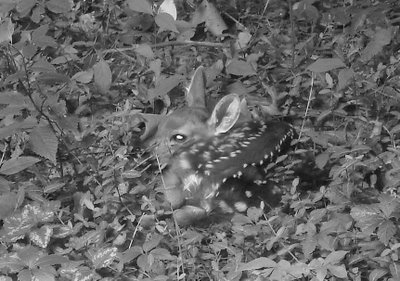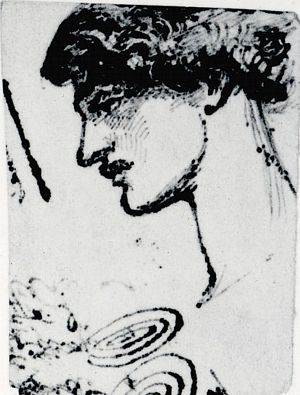Utter fawning.

I heard from one of my students today that she had an extraordinary time on a recent trip she took, in connection with research she's been helping conduct this summer. As part of this trip, she had to handle hundreds of birds every day, and she saw chicks everywhere. Apparently--and this is the part of the story I like best--she bet that she would not melt when she saw the chicks. But then she did melt at the very sight of them. And so she lost her bet.
Not an hour after I received the e-mail bearing this story, I was making my slow-driving way home from the officehouse to my excellent friends' dog, thinking about whether I'd feed him or walk him first. Suddenly, as I rounded the corner, I stopped short before the utterly unexpected sight of a doe standing in the middle of the road, nursing her tiny fawn, the tiniest fawn I have ever seen. I don't know from fawn ages and sizes; I'm not that kind of naturalist (yet). But I'd guess that this fawn was a good two weeks younger than any I've ever seen before. I stopped and waited, hoping that both fawn and doe (who had separated as soon as I materialized) would cross the road and reunite. The doe made it swiftly and surely, of course; that's what does in Gambier do. But the fawn, no bigger than a medium-sized dog (though with slightly longer legs), was still so rickety and tentative that it barely made it to the edge of the road. When all was clear, I eased on the rest of the way to my friends' house.
When I walked the dog a few minutes later, I was startled to find that the fawn had simply lain down at the edge of the woods, near the side of the road. It was the last thing I'd have expected that the fawn would do--or, more to the point, that the doe would allow. This mother was nowhere to be seen. She had made it quite a ways into the woods as I was driving past, but I had assumed she would come right back as soon as I was gone. And yet, there was the fawn, curled on its side, lying very still, looking out at the road, watching and waiting. The dog did not notice this small creature, for which I was grateful, since it was a good bit smaller than he is, and probably not nearly as fast (even with me attached to his neck). Nor did he spot it on the way back home from our walk.
Once we reached the house, I fixed the dog's dinner and then skipped out with my camera, hoping simultaneously that the fawn would be gone (rescued by its mother) and that it would still be there, still and silent and spotted. And there, indeed, it was. I tried not to get too close to it, since I guessed that it was probably already frightened enough. And it was clear to me from the moment I saw this fawn that it was not meant to be the best of all my life's photo opportunities. There was simply too much fragility and delicacy in the scene, and in the creature, for it all not to be the quintessence of ephemerality. You cannot imagine, from my picture, just how small this fawn was.
Before this afternoon, it had never occurred to me that one reason fawns are spotted might be so that they blend in with the sun-dapple on forest-floor leaves.


0 Comments:
Post a Comment
<< Home